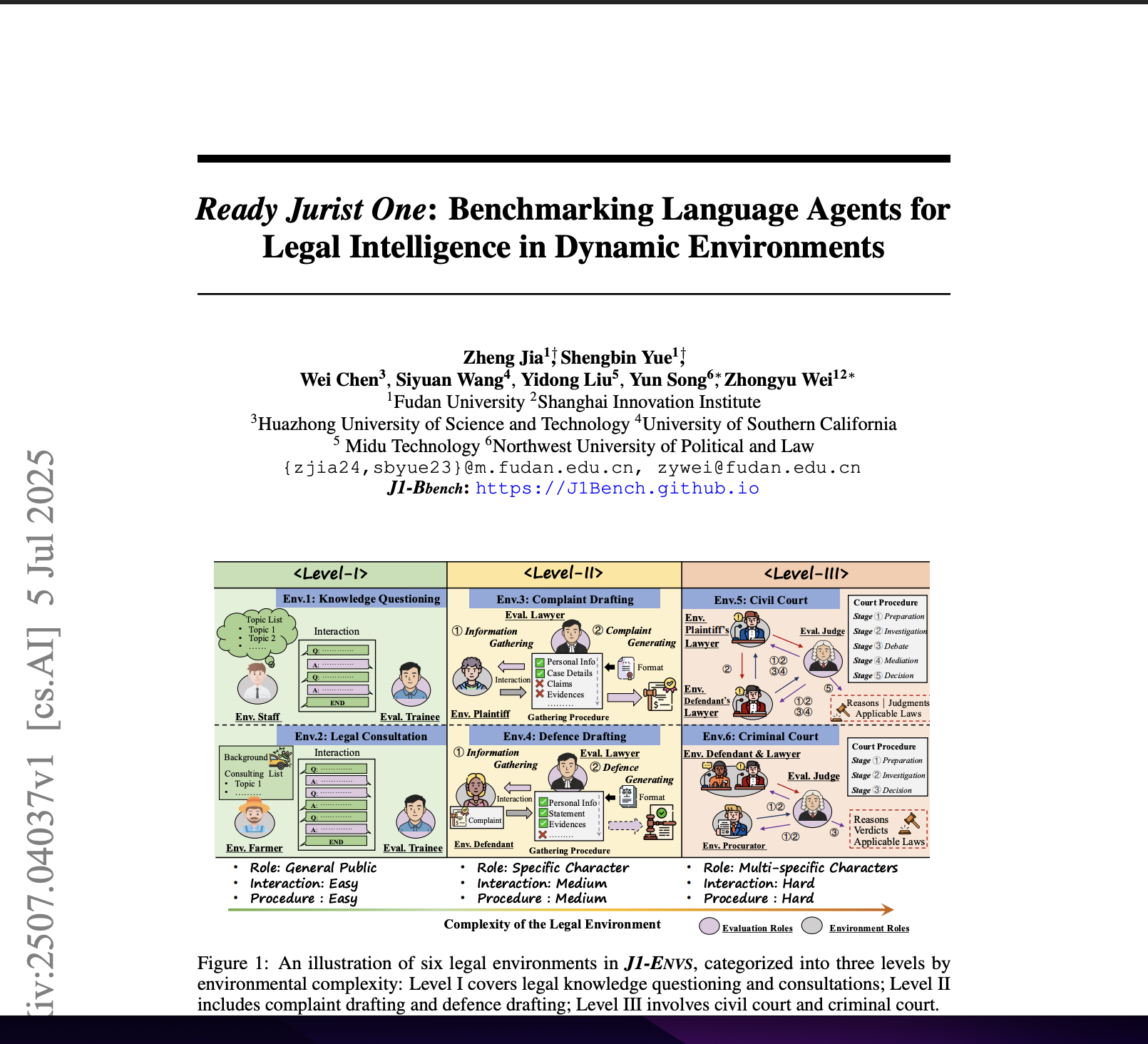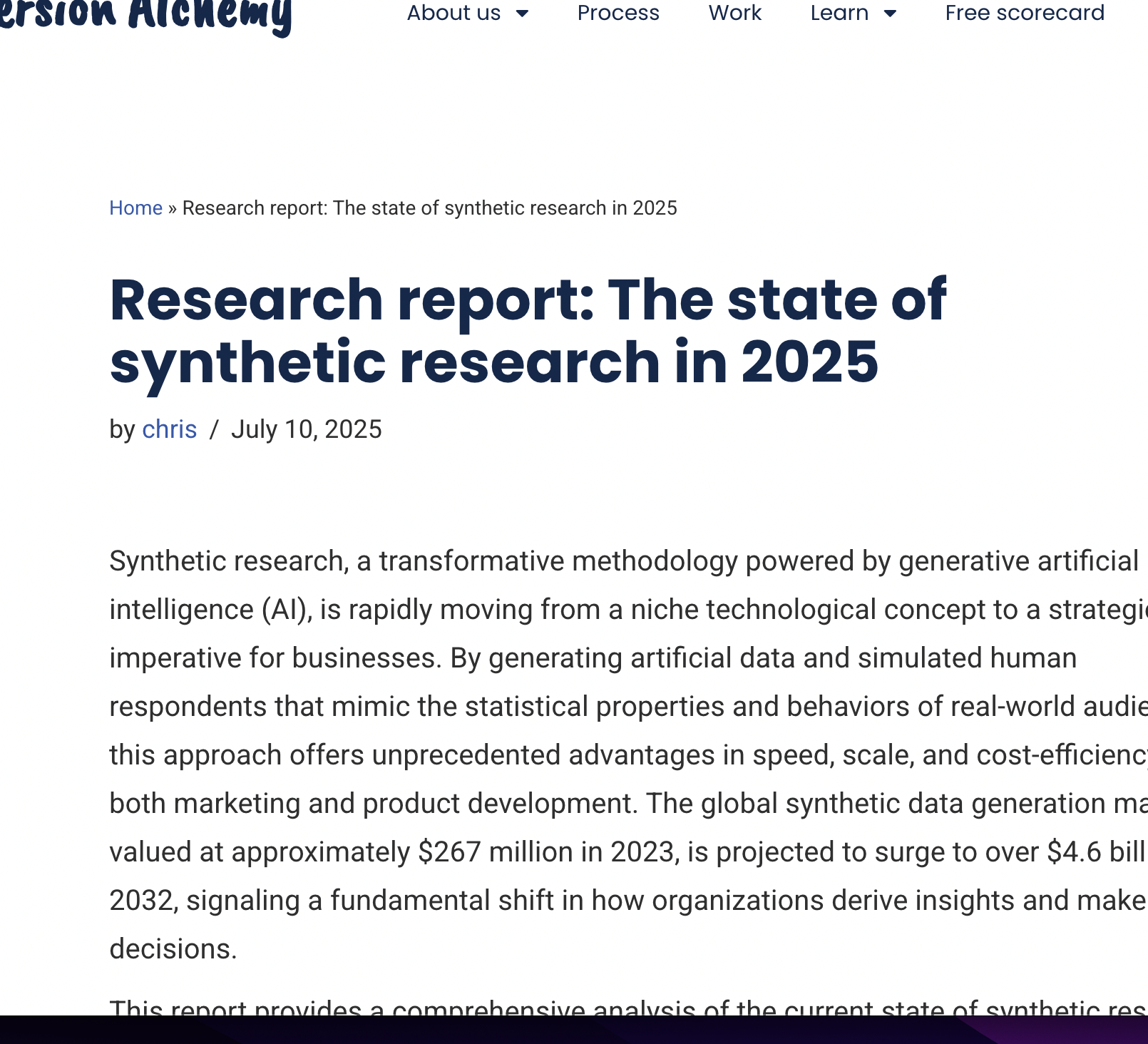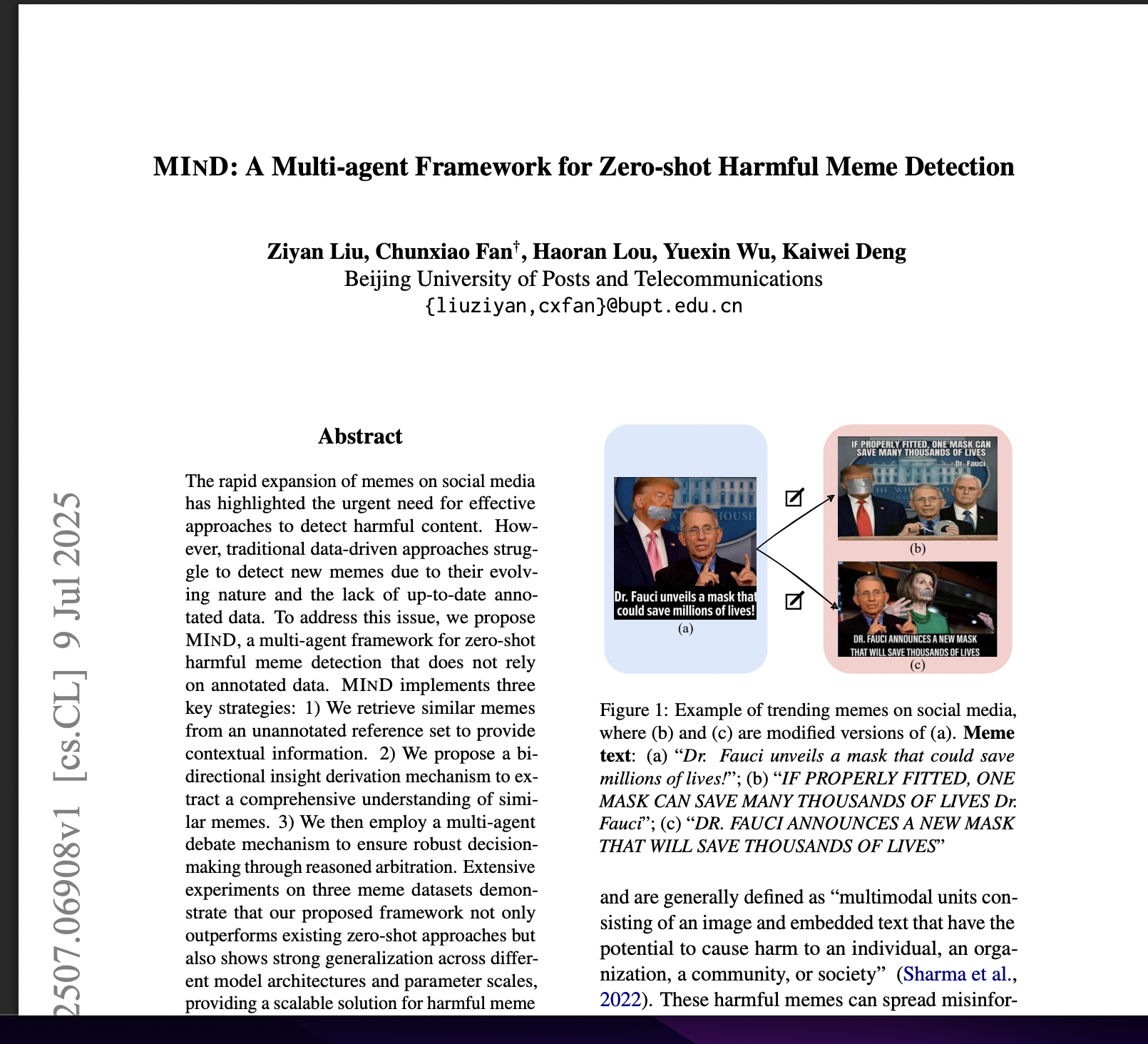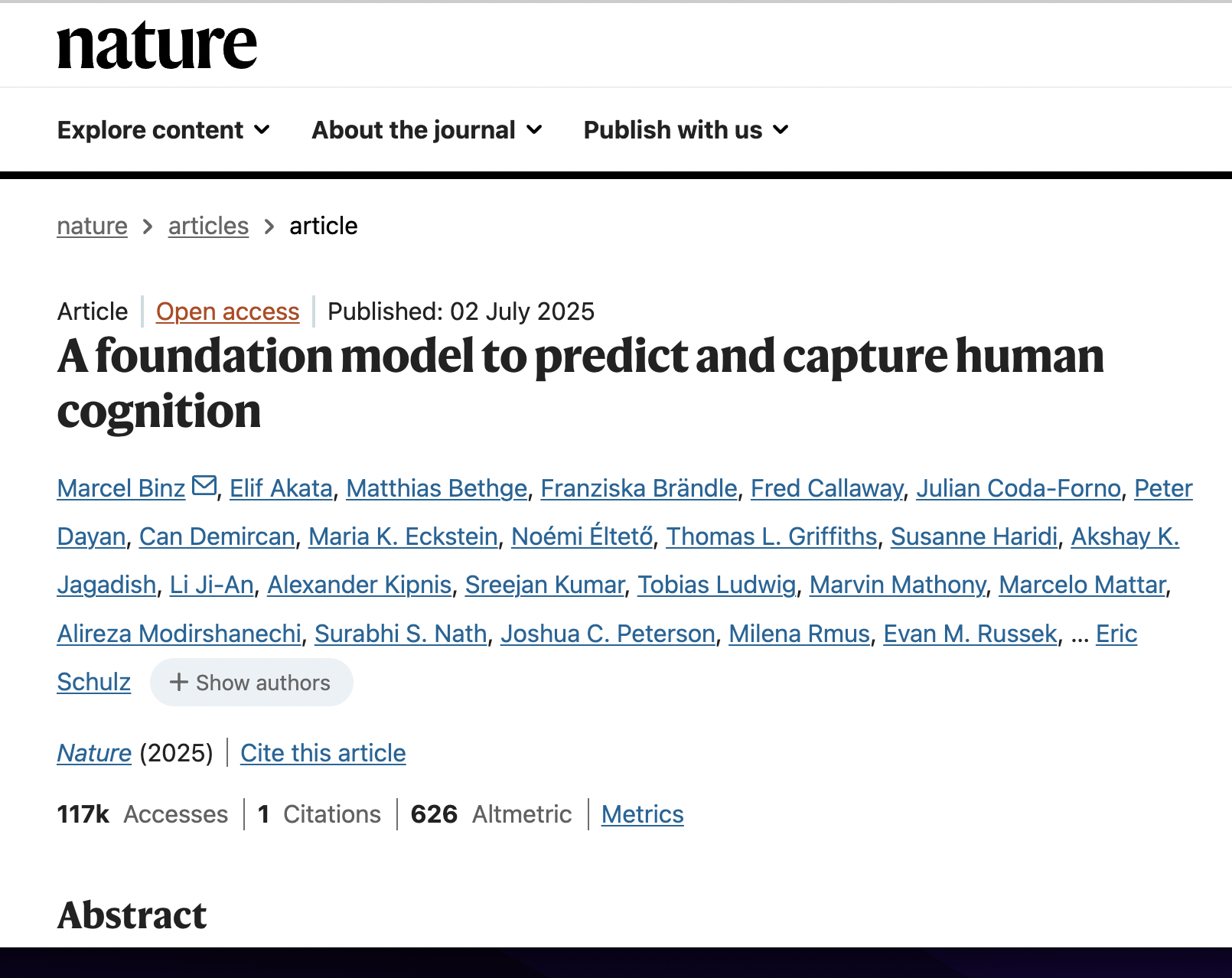LLM Generated Persona is a Promise with a Catch
postAng Li, Haozhe Chen, Hongseok Namkoong, Tianyi Peng
Published: 2025-05-18
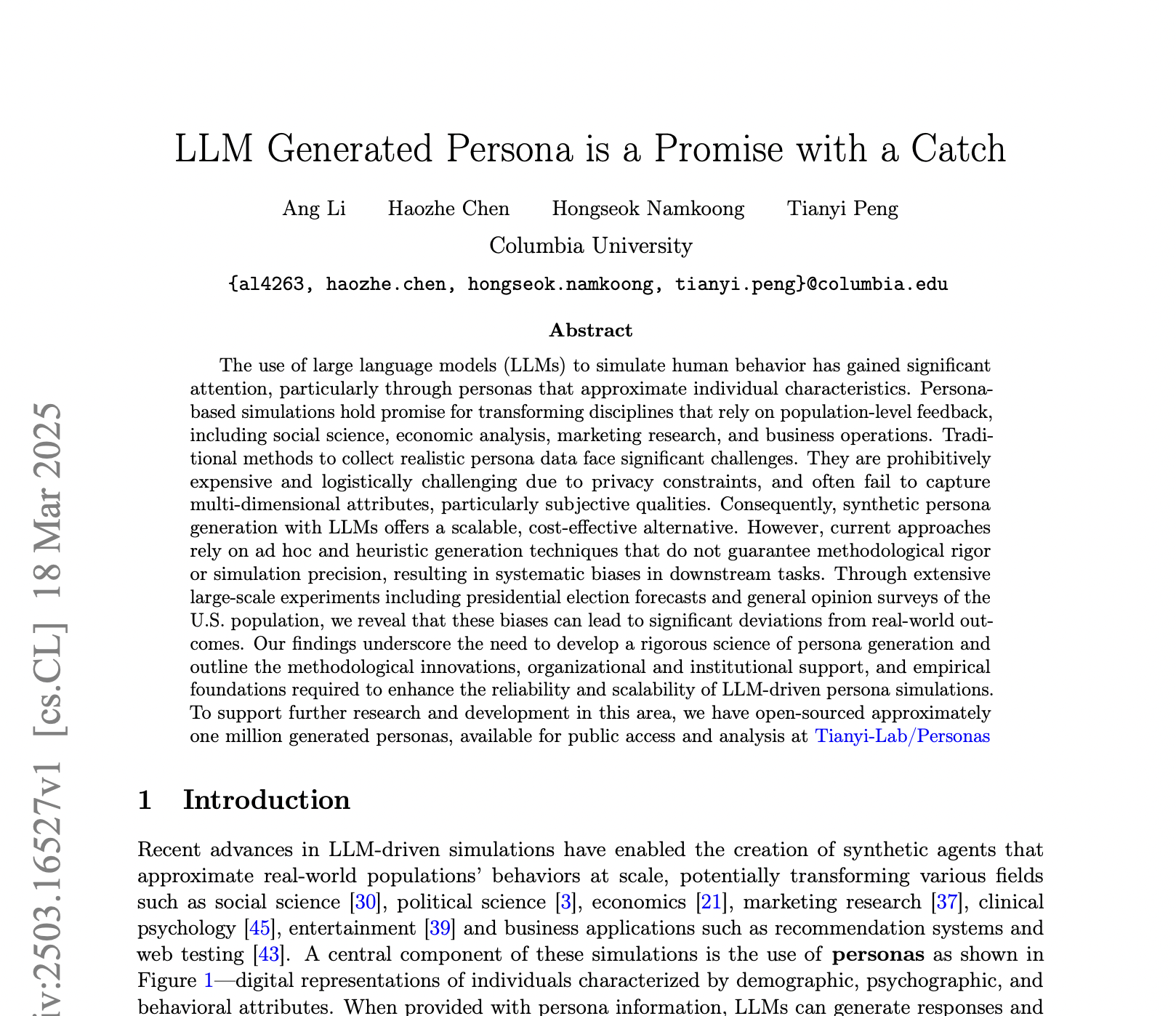
🔥 Key Takeaway:
The more "realistic" and detailed you make your AI personas—with backstories, personality quirks, and rich descriptions—the farther their answers drift from how real people actually behave; in synthetic market research, the stripped-down, census-style profiles consistently outperform the richly imagined ones.
🔮 TLDR
This paper shows that current methods for generating AI personas with large language models (LLMs) for surveys and simulations introduce systematic biases that can significantly skew results away from real-world outcomes. In large-scale tests, including U.S. election simulations and 500+ opinion questions, personas generated with more LLM content consistently produced results that were more left-leaning and less representative of actual public opinion, regardless of the underlying model used. The bias is not just in model responses, but in the persona creation step itself—personas become more optimistic, progressive, and emotionally positive as more details are generated by LLMs, and lack negative or challenging life experiences. The paper recommends using census-derived statistical sampling for core demographic attributes and only supplementing with LLM-generated content where necessary. It cautions against relying on freeform or highly detailed LLM personas for market research or opinion testing, as this can lead to overconfident, homogeneous, and unrepresentative results. Actionable steps suggested include using structured templates, benchmarking simulated distributions against real survey data, and developing calibration methods to better match joint real-world attribute distributions. The authors open-sourced a dataset of ~1 million personas to support further research.
📊 Cool Story, Needs a Graph
Figure 1: Simulated Elections (2016–2024)
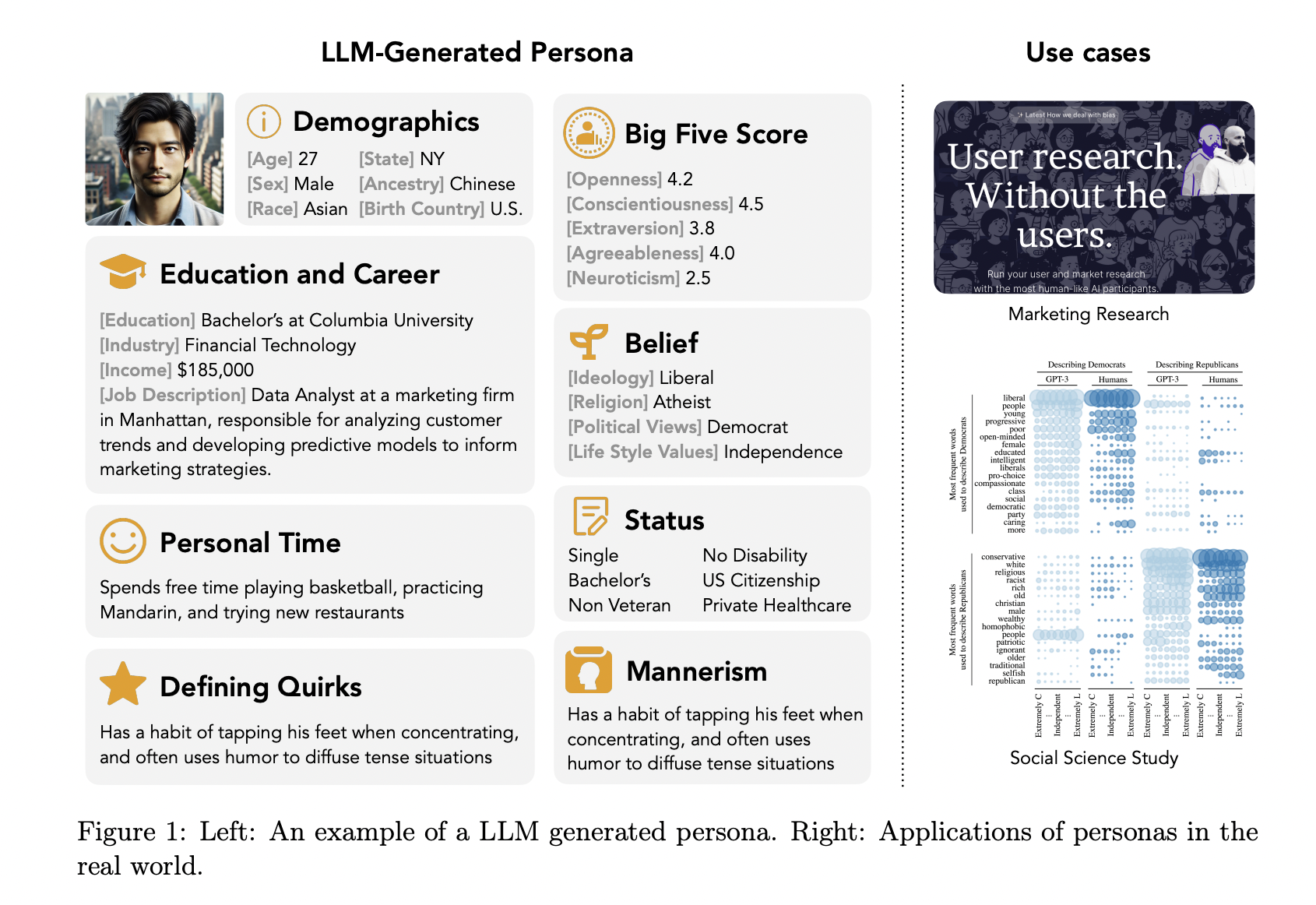
Predicted US presidential election outcomes using three types of LLM-generated personas—Meta, Tabular, and Descriptive—show increasing divergence from historical results as persona freedom increases.
This figure shows how different methods of generating AI personas affect the predicted outcomes of US presidential elections from 2016 to 2024. The Meta personas, based strictly on demographic data, produce election results closest to the actual outcomes. As the persona descriptions become more open-ended (Tabular and then Descriptive), the predictions shift unrealistically, with Descriptive personas predicting a clean Democratic sweep across all years and states. This illustrates a core finding of the study: the more creative freedom allowed in persona generation, the more biased and unrepresentative the simulation results become. This is a clear visual warning that persona realism depends heavily on how strictly their attributes are defined and controlled.
⚔️ The Operators Edge
A subtle but critical detail in this study is that the researchers used *objective, structured templates for persona attributes*—explicitly aligning things like occupation, education, and income with U.S. Census categories—before letting the AI fill in any subjective or narrative details. This disciplined approach ensures that the synthetic audience reflects real-world demographic distributions and combinations, not just plausible-sounding backstories, and it is this constraint that keeps the simulated survey results tethered to actual population behavior.
Why it matters: Many experts focus on prompt design or model selection, but this study shows that *the key lever for realism is how strictly you constrain the foundation of your personas using real, externally validated data structures*. If you let the AI create “creative” personas too freely, the simulation drifts—biases appear and results become homogeneous or too optimistic. By anchoring personas in hard demographic tables, you not only prevent these biases, but also make your synthetic sample robust across different models and runs.
Example of use: A business running synthetic A/B tests for a new financial product could build persona templates directly from census data: e.g., “female, age 32, Hispanic, employed full-time, income $44K, lives in Texas” and only then ask the AI to generate subjective details like attitude toward risk or savings habits. This guarantees their virtual audience actually mirrors the intended target market, so insights about messaging or feature preference are meaningful.
Example of misapplication: If the same business skips the demographic anchoring step and prompts the AI to “create 1,000 realistic U.S. consumers with various backgrounds,” the model will likely overrepresent college-educated, urban, creative-class characters with progressive values—leading to feedback that overestimates demand for high-tech features or ethical branding, and underestimates price sensitivity or mainstream skepticism. The result: product decisions are made based on a fantasy market that doesn’t match real-world segments.
🗺️ What are the Implications?
• Base your synthetic audience on real demographic data whenever possible: Simulations that start from actual census or survey statistics produce results that better reflect real-world diversity, avoiding the risk of one-sided or unrealistic findings.
• Limit the use of highly detailed or freeform AI-generated personas: The more your simulated personas are built from open-ended or creative AI content, the more likely your results will be biased—often skewing too optimistic, progressive, or homogeneous, and missing real-world nuance.
• Use structured templates for persona creation: When adding details to your virtual participants, stick to objective, pre-defined categories (like job titles or education levels) instead of letting the AI invent subjective or lifestyle details, which reduces bias and keeps simulations grounded.
• Benchmark your simulated results against real survey data: Whenever possible, compare the output of your virtual research (e.g., opinion distributions, voting) to actual public data to spot and correct biases before you act on the insights.
• Beware of hidden ""AI preferences"" influencing your findings: The study found AI-generated personas consistently preferred certain products, policies, or brands that may not align with actual market segments; cross-check surprising results with real human samples or known market trends.
• Multiple AI models do not solve the bias problem: The systematic bias from persona generation was present across all language models tested, so simply switching models is unlikely to improve realism—focus on the persona design and data sources instead.
• Ask for transparency about persona creation in any synthetic research you fund: Ensure any vendor or team clearly documents how personas are built and what data was used, as this is a key driver of accuracy and reliability in simulated market studies.
📄 Prompts
Prompt Explanation: The AI was instructed to generate a persona by completing a structured template using provided demographic data, ensuring consistency and realism without adding extraneous details.
You are an AI assistant specialized in detailed and unbiased persona generation for opinion simulations. Your task is to generate a specific, realistic, and diverse persona based on the provided demographic information and fill in a comprehensive JSON template.
Prompt Explanation: The AI was directed to complete a persona profile with only objective, pre-defined attributes, filling in a structured format from a list of fixed values without elaboration.
### INSTRUCTIONS ###
1. You will be provided with a persona meta file that has the core demographic information of a person.
2. You will also be provided with a final persona template. Your task is to create a detailed, concrete persona that is fully consistent with ALL features in the given metadata by filling the template.
3. Elaborate on all metadata points, providing specific details that flesh out the persona while remaining true to the given information.
4. For all of the features in the metadata, you will be provided with a range of values in the VALUE RANGES AND CATEGORIES section below. Select one of the values for each of the features. DO NOT ADD EXTRA INFORMATION OR ELABORATION TO THE VALUES. DO NOT ADD EXTRA FEATURES TO THE TEMPLATE.
5. IMPORTANT: Place your entire response in the ### PERSONA GENERATION ### section below. Start your response with ‘Persona:’ and then provide only the persona description. Do not include any other prefixes, headers, or additional text.
Prompt Explanation: The AI was guided to generate a persona using both structured data and some free-form subjective descriptions, maintaining a balance of realism and richness.
### INSTRUCTIONS ###
1. You will be provided with a persona meta file that has the core demographic information of a person.
2. You will also be provided with a final persona template. Your task is to create a detailed, concrete persona that is fully consistent with ALL features in the given metadata by filling the template.
3. Elaborate on all metadata points, providing specific details that flesh out the persona while remaining true to the given information.
4. For some of the features, you will be provided with a range of values in the VALUE RANGES AND CATEGORIES section below. Select one of the values for each of the features. DO NOT ADD EXTRA INFORMATION for those features.
5. For the other features, fill in the values with a reasonable and succinct description. Be as objective as possible.
6. IMPORTANT: Place your entire response in the ### PERSONA GENERATION ### section below. Start your response with ‘Persona:’ and then provide only the persona description. Do not include any other prefixes, headers, or additional text.
Prompt Explanation: The AI was prompted to generate a vivid and richly detailed free-form persona based solely on given metadata, emphasizing narrative and diversity.
### INSTRUCTIONS ###
1. You will be provided with a persona meta file that has the core demographic information of a person.
2. Your task is to create a detailed, diverse, and vivid persona that is fully consistent with ALL features in the given metadata.
3. Elaborate on all metadata points, providing specific details that flesh out the persona while remaining true to the given information.
4. For any ranges or categories provided in the metadata, select and specify exact values or details within those ranges/categories.
5. Ensure diversity in perspectives, backgrounds, and personality traits. Provide enough specific details to make the persona feel real and three-dimensional.
6. Maintain diversity by acknowledging various experiences within the demographic group, but commit to specific details for this individual persona.
7. IMPORTANT: Place your entire response in the ### PERSONA GENERATION ### section below. Start your response with ‘Persona:’ and then provide only the persona description. Do not include any other prefixes, headers, or additional text.
Prompt Explanation: The AI was tasked with simulating an opinion for a given persona on a specific topic, choosing from multiple-choice options while ensuring alignment with the persona’s attributes.
You are an AI assistant tasked with generating realistic opinions based on a given persona and a specific topic.
### TASK
You will simulate a persona answering a multiple-choice opinion question. Select the answer that best matches your persona’s viewpoint and interests.
### GUIDELINES
1. Be Faithful to the Persona: Ensure your answer is consistent with the persona’s data.
2. Focus on Relevant Aspects: Center your reasoning on the relevant factors that would influence the persona’s opinion on that topic.
3. Be Objective: Avoid injecting personal bias or overly politically correct views that may not align with the persona’s standpoint.
### INSTRUCTIONS
* Choose ONE option (A, B, C, or D depending on the number of options) that best fits the persona
* If multiple answers are possible, randomly select based on their probability
* Always pick an option, even in unclear cases - treat it as a forced-choice survey
* Output format: ‘Answer: \[Letter]’ only, no explanation needed
### PERSONA
{PERSONA}
### QUESTION
{QUESTION}
### YOUR RESPONSE
⏰ When is this relevant?
A national grocery chain wants to test how different customer types would react to a new “local produce” section in their stores, aiming to understand which messages drive interest and what objections might arise. The team wants to use AI personas to simulate responses from three key audience segments: health-focused urban professionals, price-sensitive suburban families, and convenience-oriented rural shoppers.
🔢 Follow the Instructions:
1. Define your audience segments: Write a short, realistic profile for each key segment based on actual customer data or market research. For example:
• Health-focused urban professional: 32, single, lives in a city, prioritizes nutrition and sustainability, shops weekly, moderate income.
• Price-sensitive suburban family: 44, married, two kids, lives in suburbs, cares about value and deals, shops in bulk, tight budget.
• Convenience-oriented rural shopper: 55, lives in a rural area, shops infrequently, prefers one-stop solutions, less concerned with organic claims.
2. Prepare your persona prompt template: For each segment, use this prompt structure:
You are [persona description].
Today, you are shopping in your usual grocery store and see a new section labeled “Local Produce—Fresh from Nearby Farms.”
As a customer, describe your honest first reaction to this new section in 3–5 sentences. Talk about what you like, what you’re unsure about, and whether you’d be likely to buy anything from it.
3. Generate responses using an AI model: For each persona, input the prompt above into GPT-4 or a similar AI. To get a range of perspectives, run the prompt 3–5 times per persona, slightly varying the wording (e.g., “What stands out to you about the local produce?” or “Would you trust the quality or pricing in this new section?”).
4. Probe for deeper feedback with follow-up prompts: For each persona, ask a follow-up using this template:
Thanks for sharing your first reaction. What would make you more likely to shop from the local produce section in the future? Are there any concerns or questions you’d want answered first?
5. Tag and categorize the responses: Review the AI outputs for each persona and tag common themes (e.g., “mentions freshness,” “concerned about price,” “likes supporting local,” “worried about selection,” “indifferent”).
6. Compare and extract insights across audiences: Summarize what motivates or deters each segment, highlighting any messaging that works particularly well (e.g., “urban professionals focus on sustainability claims,” “suburban families need value messaging,” “rural shoppers want convenience and trust in source”).
🤔 What should I expect?
You’ll get a clear, actionable picture of what each key customer type values, what objections or questions they have, and which marketing messages are likely to resonate most. This will help your team refine in-store signage, advertising, and future promotions before investing in a real-world rollout.<br>

